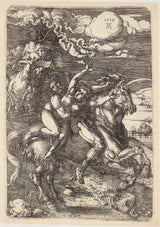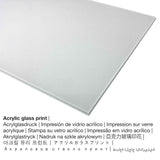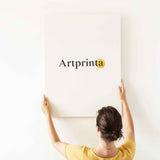Albrecht Dürer, 1516 - Abduction on a Unicorn - fine art print
Tax included. Shipping calculated at checkout.
Article specs
The artwork Abduction on a Unicorn was created by Albrecht Dürer in 1516. Moveover, the work of art belongs to the Statens Museum for Kunst (National Gallery of Denmark)'s digital collection, which is located in Copenhagen, Denmark. With courtesy of National Gallery of Denmark (license: public domain).: . Moreover, alignment of the digital reproduction is portrait and has a ratio of 1 : 1.4, which implies that the length is 29% shorter than the width. Albrecht Dürer was a male painter, whose artistic style can primarily be attributed to Northern Renaissance. The artist was born in the year 1471 and died at the age of 57 in 1528.
Order your preferred item material
The product dropdown menu provides you with the possibility to choose your favorite material and size. In order match your personal requirements perfectly, you can choose among the following product customization options:
- The poster print on canvas material: Our poster print is a UV printed canvas with a slight finish on the surface. Please note, that depending on the absolute size of the poster print we add a white margin between 2-6cm round about the print to facilitate the framing with your custom frame.
- Aluminium dibond print: Aluminium Dibond prints are metal prints with an impressive depth - for a modern impression and non-reflective surface structure. A direct Direct Print on Aluminum Dibond is your ideal start to fine replicas manufactured with aluminum. The bright and white components of the original artwork shine with a silky gloss but without any glare.
- Canvas: A UV printed canvas stretched on a wooden frame. Besides, printed canvas makes a attractive and positive look. The great advantage of canvas prints is that they are relatively low in weight, which implies that it is quite simple to hang up the Canvas print without additional wall-mounts. A canvas print is suited for any type of wall.
- Acrylic glass print: An acrylic glass print, which is often named as a an art print on plexiglass, changes your favorite original work of art into wonderful home decoration. With an acrylic glass art print contrasts plus granular artwork details become more visible thanks to the very subtle tonal gradation in the picture.
Legal disclaimer: We do in order to depict our art products as precisely as possible and to demonstrate them visually. Still, the pigments of the print products and the printing can diverge to a certain extent from the image on your monitor. Depending on your screen settings and the condition of the surface, not all colors will be printed as exactly as the digital version on this website. Because our art reproductions are processed and printed by hand, there might as well be minor differences in the exact position and the size of the motif.
About the item
| Product type: | art copy |
| Method of reproduction: | digital reproduction |
| Manufacturing method: | UV direct print |
| Production: | German-made |
| Stock type: | production on demand |
| Intended usage: | home décor, home design |
| Orientation: | portrait alignment |
| Side ratio: | 1 : 1.4 (length : width) |
| Aspect ratio implication: | the length is 29% shorter than the width |
| Available material options: | poster print (canvas paper), canvas print, acrylic glass print (with real glass coating), metal print (aluminium dibond) |
| Canvas print (canvas on stretcher frame) options: | 50x70cm - 20x28", 100x140cm - 39x55" |
| Acrylic glass print (with real glass coating) size options: | 50x70cm - 20x28", 100x140cm - 39x55" |
| Poster print (canvas paper) sizes: | 50x70cm - 20x28" |
| Dibond print (alumnium material) options: | 50x70cm - 20x28", 100x140cm - 39x55" |
| Frame: | unframed product |
Background information about the original artwork
| Title of the artpiece: | "Abduction on a Unicorn" |
| Classification: | painting |
| Broad category: | classic art |
| Century: | 16th century |
| Artwork year: | 1516 |
| Approximate age of artwork: | around 500 years old |
| Exhibited in: | Statens Museum for Kunst (National Gallery of Denmark) |
| Museum location: | Copenhagen, Denmark |
| Available under: | www.smk.dk |
| License of artwork: | public domain |
| Courtesy of: | National Gallery of Denmark |
Brief overview of the artist
| Artist: | Albrecht Dürer |
| Artist gender: | male |
| Nationality: | German |
| Jobs of the artist: | painter |
| Country of the artist: | Germany |
| Artist category: | old master |
| Styles of the artist: | Northern Renaissance |
| Died at the age of: | 57 years |
| Birth year: | 1471 |
| Year died: | 1528 |
| Place of death: | Nuremberg |
© Copyright | Artprinta.com
(© - Statens Museum for Kunst (National Gallery of Denmark) - Statens Museum for Kunst (National Gallery of Denmark))
In spite of great diligence and learning, no-one has as yet provided an entirely satisfactory account of the underlying meaning of this iron etching. Scholars have searched in vain for a literary source within classical mythology and German legend.
The picture's unsolvable rebus A naked horseman, his hair and beard wild and unkempt, his appearance very much like that of Dürer himself, grabs an equally naked, high-bosomed woman and abducts her on a horned, horse-like creature, presumably one of those unicorns that many have heard of but never seen.
A hidden reference to something private? A self-penned anecdote? At any rate, the picture is as yet a puzzle, an unsolvable rebus that challenges our minds and imaginations, forcing spectators to see the picture rather than merely note it.
Prints of six iron ecthings Only six iron etchings by Dürer’s hand are known today. The Department of Prints and Drawings owns prints of every one of them, even of an unusually high quality – printed before the rust set in!
Usually, graphic artists will use plates made from copper or zinc for etchings, but Dürer chose to experiments with iron plates. Every time he made a print, the inkcovered plate met a piece of damp paper. Eventually this created rust stains that appeared as shadows on the paper.
To an artist as perfectionist as Dürer, this was probably sufficient reason for conclusively returning to woodcuts and copper engraving.














